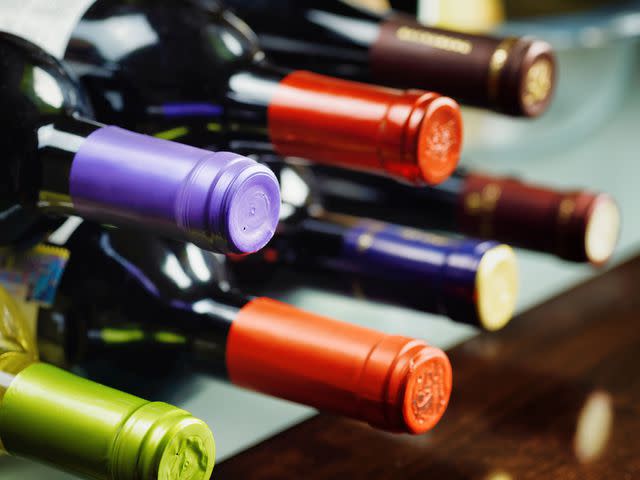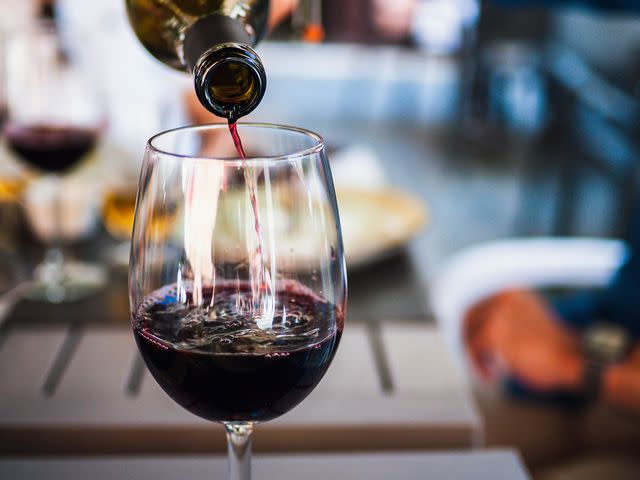How to Store Wine to Keep It Fresh
You don't need a special wine fridge to keep your bottles tasting their best.

Tetra Images/Getty Images
Are you tired of making pour decisions when it comes to wine storage? After spending money on your favorite bottles, of course you want to preserve their quality for as long as possible. Here’s everything you need to know about keeping unopened and opened bottles fresh for as long as possible.
How to Store Unopened Wine
Keep your uncorked wine collection in tip-top shape with these simple storage tips.

efired/Getty Images
Temperature Is Key
The ideal temperature for wine storage is between 45 and 65 degrees F. (Many purists keep their collection at exactly 55 degrees F.) Anything above 70 degrees F can degrade the wine, while cold temperatures could dry out the cork and allow oxygen inside the bottle. Kitchen refrigerators should be kept at 40 degrees F or slightly below to ensure food safety, so your main fridge is not your best bet for long-term wine storage.
More important, though, is to keep the temperature consistent. Extreme temperature changes will cause the liquid to expand and contract, which could cause seepage.
Do You Need a Wine Fridge?
It depends on how serious you are about your wine. If you typically only keep a few bottles around your house at a time for casual drinking, a wine fridge likely an unnecessary expenditure.
However, if you are an avid collector or someone who enjoys having a wide selection available at all times, a dedicated wine fridge may very well be a worthwhile purchase. This is especially true if you live in a hot or humid climate — a wine fridge ensures your expensive bottles are protected from the inhospitable environment.
Related:How to Save Money on Your Daily Wine
Choose a Dark Area
Avoid storing unopened wine in rooms that receive a lot of sun, as UV rays can cause the wine to spoil prematurely. But it’s not just sunlight! If you have the option, keep the lights off. Even fluorescent bulbs can degrade your wine over time.
Always Store Horizontally
The direction in which you store your bottles is an important factor in wine longevity, but a lot of people don’t realize they shouldn’t store them upright. This keeps the liquid against the cork, which prevents it from drying out and allowing air to seep inside. Instead of keeping your bottles standing on the kitchen counter, invest in a wooden wine rack that keeps them horizontal.
Avoid Humidity Extremes
The humidity sweet spot for wine storage is between 50 and 80 percent. Anything too high may result in mold, while anything too low could dry out the corks. If you’re concerned that the air is too dry where you’re storing your wine, place a pan of water in the area or mist the wooden walls or wine rack with water every so often.
Related:How Many Glasses of Wine Are In a Bottle?
Know When Wine Is Past Its Prime
Even if it’s stored perfectly, most wine isn’t meant to last forever. Talk to your local wine shop owner if you’re looking for a bottle that will last 10 years or more. Otherwise, try to consume your reds within three years and whites within one year.
How to Store Open Wine
If you’ve opened a bottle you don’t plan to finish within a few hours, here’s what to do.

Rafa Elias/Getty Images
Reduce Oxygen Exposure
The most important thing when it comes to wine storage is to keep oxygen out of the bottle. This becomes more difficult once you’ve popped the cork, so it’s imperative that you seal the opening tightly. You can buy wine stoppers that actually remove excess air from the bottle before sealing. These will keep leftover wine fresh for about a week. In a pinch, though, use the cork the bottle came with.
Related:We Tested 14 of the Best Wine Decanters, and These 6 Produce Better Tasting Vino
Refrigerate and Keep the Temperature Steady
Refrigeration slows the deterioration of your wine. Sealed tightly in the fridge, wine can last three to five days after opening. So yes, you should even refrigerate your opened red wine. To return the bottle to your desired temperature for drinking, place the bottle in a lukewarm bath.
Store It Upright
I know, I know — I just told you that wine bottles should be stored horizontally. However, once they’ve been opened, vertical is best. This position minimizes the surface area that’s exposed to any oxygen that may seep into the bottle.
Related:What to Do With Leftover Wine
Avoid Sunlight
It’s tempting to leave leftover wine on the counter, but you’ll want to avoid doing that, especially if your kitchen gets a lot of sunlight. If you plan to drink the wine within the next day and absolutely do not want to refrigerate it, the inside of your pantry or a closed cabinet are the safest choices.

